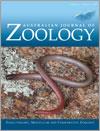This study documents the parasite assemblage of Liasis fuscus Peters, 1873 from the Adelaide River flood plain, Northern Territory, Australia. In total, nine species of helminth (comprising three cestodes and six nematodes), one pentastome and one protozoan were found in 180 water pythons, with the Nematoda being the dominant and most diverse group, and a cestode, Bothridium ornatum Maplestone & Southwell, 1923, the most prevalent species. In spite of the hosts being present in high numbers the helminth assemblage was depauperate, characterised by low prevalence, intensity, frequency and abundance of species, with neither season nor sex of host affecting abundance. There were, however, significant differences between ages of hosts, juveniles having fewer parasites, and seasonal diversity, with the wet season of 2004 and the dry of 2005 the most similar. Of the Australian python species analysed Morelia spilota (Lacépède, 1804) had the highest species richness. The lower species richness found in L. fuscus was possibly due to its unusual biology. Biogeographic relationships of the parasite fauna of L. fuscus are diverse, connections with Africa, Asia, and South America being noted.
How to translate text using browser tools
17 March 2015
The endoparasites of Liasis fuscus (Serpentes : Boidae) from the Adelaide River floodplain, Northern Territory, Australia
E. Mulder,
L. R. Smales
ACCESS THE FULL ARTICLE

Australian Journal of Zoology
Vol. 63 • No. 2
May 2015
Vol. 63 • No. 2
May 2015




